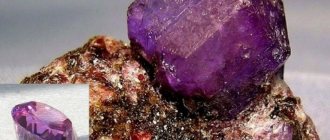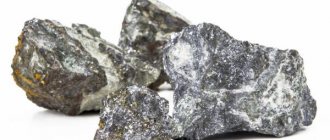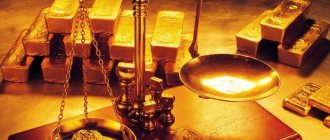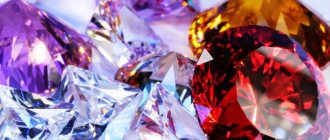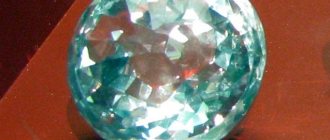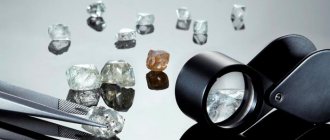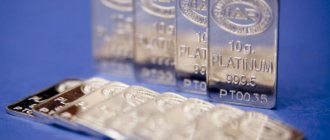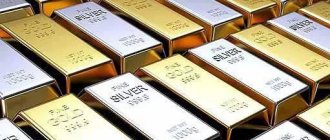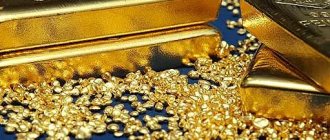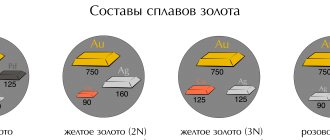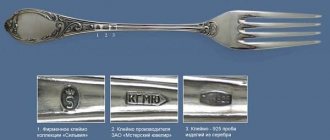We present to your attention the most valuable and expensive precious metals. It turns out that there are materials in the world that are much more expensive than platinum and gold, which we know very well.
First, let's look at natural precious metals. Please note that prices may be outdated, but the order of precious metals in terms of cost has not changed.
Rhodium $225.1 per 1 gram
Opened in 1803. World reserves of rhodium are estimated at only a few tons, and annual production is measured at hundreds of kilograms. Rhodium is such an expensive metal that it is most often used only in those areas where it is absolutely irreplaceable. 98% of rhodium is used to produce automobile catalysts. In recent years, the need for rhodium has increased 10–13 times. The high cost of the metal forced the search for equivalent substitutes, which is done in the USA, Japan and other developed countries.
Platinum $70 per gram
Platinum was known in Ancient Egypt, Greece, Ethiopia and South America. At first, platinum was considered white gold, but no use could be found due to the difficulty of processing it. Counterfeiters were the first to use platinum, since a cheap, fairly heavy (compared to silver and gold) metal with a high density could weigh down coins.
Gold
Cost: $56 per gram.
Gold is a very heavy metal: the density of pure gold is 19,621 kg/m. Among metals it ranks sixth in density: after osmium, iridium, rhenium, platinum and plutonium. The high density of gold makes it easier to mine. The simplest technological processes, such as washing at sluices, can provide a very high degree of gold recovery from the washed rock.
Gold $45 per 1 gram
Gold is the main precious metal, recognized as such throughout the world since ancient times. Gold seems to have been created by nature itself for minting coins and making jewelry: it is found exclusively in its pure form, ductile and resistant to corrosion, homogeneous, compact, in short, an ideal, in a sense, metal. Now you can buy gold in jewelry stores and in banks.
Alloy classification
The classification of nickel alloys is based on composition and properties.
Acid resistant
Alloys with additive-alloying of other metals:
- Chromium and tungsten give the alloy resistance in aggressive oxidizing environments.
- Compounds with copper or molybdenum are used in aggressive non-oxidizing environments.
Corrosion resistance is provided by silicon and aluminum.
Heat resistant
Alloys such as “nickel + chromium + additives of other alloying elements”. Such elements are aluminum, tungsten, titanium, molybdenum, strontium, and others.
Such metal alloys are in demand for the manufacture of power plant components subject to maximum loads.
Osmium $25 per gram
The Greek word osme (smell) gave the name to the platinum metal osmium, discovered 200 years ago. It does have an unpleasant, irritating odor, similar to a mixture of bleach and garlic. Pure osmium has not been found in nature and is only known to be bound in minerals by another platinum metal, iridium. Such minerals are found in Siberia, the Urals, and abroad - in South Africa, the USA, Colombia and Canada. There is very little osmium in the earth's crust, it is extremely dispersed and therefore expensive. Because of this, osmium is used only where a significant effect can be achieved at low cost. The United States, for example, imports a little more than 100 kilograms of osmium per year, mainly for the production of the drug cortisone. Very little osmium is consumed by the chemical industry for the manufacture of catalysts.
Iridium $20 per gram
Iridium was discovered in 1803. Iridium is a silvery-white metal, similar in appearance to tin, very hard, heavy and strong, but brittle. The independent use of iridium is quite rare and most often it is used as an alloy. Adding 10% iridium to relatively soft platinum makes it almost three times harder. For jewelers, this quality of iridium is absolutely irreplaceable, since jewelry made from a platinum-iridium alloy is very beautiful and practically does not wear out. It is curious that the same alloy is used to make weight and length standards. It is also used for the manufacture of electrical contacts, surgical instruments, and precision chemical balances. Iridium is used to make the nibs of expensive fountain pens. Iridium-platinum alloys are used in biomedicine and aerospace engineering. The world consumes a little more than a ton of iridium per year. Two-thirds is consumed by the chemical industry; the rest of iridium is used in various catalytic processes, in jewelry and dental alloys, as well as for the production of crucibles and combat lasers. This platinum metal comes almost entirely from South Africa.
Classification and types of precious metals and precious stones
Precious metals and stones began to be classified in ancient times; today there are many different classifications of both precious metals and precious stones. We will present some of them in this article, and also consider the main aspects of the turnover and accounting of precious metals and stones.
Types and classifications of precious metals
established classification of precious metals . However, traditionally they are simply distinguished by type:
- gold;
- silver;
- platinum group metals (platinum, palladium, iridium, ruthenium, osmium, rhodium).
Precious metals can be in the form of ingots.
It is also possible to propose a classification of precious metals according to the criterion according to which the metals are or are not traded on the world market. In this case, two groups of precious metals can be distinguished:
- Those that are traded on the world market (gold, silver, platinum, palladium).
- Those that are not traded on the world market (iridium, osmium, ruthenium, rhodium).
Traditional classification of stones
Regarding the classification of precious stones, the situation is much simpler.
Did you know that the first classification of precious and semi-precious stones was presented to the world in 1860 by the German scientist K. Kluge.
Each precious stone is unique in its own way.
The scientist justified from a scientific point of view the need to divide stones into two groups:
- truly precious minerals;
- standard precious minerals (semi-precious stones).
The first group of stones consisted of samples, which the scientist further divided into three classes, and the second into two classes.
Thus, the first class of the first group of precious stones were:
- diamond;
- corundum;
- chrysoberyl;
- spinel.
The second class of the first group included the following stones:
- zircon;
- beryl;
- topaz;
- tourmaline;
- pomegranate;
- noble opal
The scientist classified the following stones into the third class of the first group
- cordierite;
- Vesuvian;
- chrysolite;
- axinite;
- kyanite;
- stavroline;
- andalusite;
- chiastolite;
- epidote;
- turquoise.
We will not focus your attention on the classifications of semi-precious stones in the context of this article; we will only reveal the features of the grouping and classification of exclusively precious stones.
Modern classification of stones
Modern classification of precious stones involves their division into two groups:
- precious stones (gems);
- colored stones.
Precious stones are divided into three classes, the first of which includes:
- diamond;
- emerald;
- alexandrite;
- chrysoberyl;
- euclase;
- noble spinel;
- ruby;
- sapphire;
- padparadscha (orange sapphire).
The second class of gems includes the following stones:
- topaz;
- aquamarine;
- sparrow;
- heliodor;
- pink tourmaline;
- siberite;
- phenacite;
- amethyst;
- zircon;
- noble opal
The third class of gems consists of the following stones:
- turquoise;
- rhinestone;
- chrysoprase;
- cornelian;
- agate;
- bloodstone;
- amber;
- jet and others.
The group of colored stones further divides stones into two classes, the first of which includes:
- malachite;
- rhodonite;
- nephritis;
- lapis lazuli;
- amazonite;
- Labrador;
- aventurine;
- chalcedony;
- written granite and others.
The second class of colored stones includes, in particular, the following:
- ophiocalcite;
- agalmatolite;
- marble onyx;
- fluorite;
- selenite;
- jasper;
- meerschaum and others.
Household classification of stones
The classification presented above, while certainly modern and adapted, is not always clear to the common man, and therefore scientists have developed the so-called “everyday classification” of all stones, according to which all precious stones are divided into two grades.
First grade precious stones include:
- diamond;
- sapphire;
- ruby;
- chrysoberyl;
- alexandrite;
- emerald;
- lal;
- spinel;
- euclase
The group of second grade precious stones consists of:
- topaz;
- aquamarine;
- beryl;
- red tourmaline;
- demantoid;
- phenacite;
- blood amethyst;
- almandine;
- hyacinth;
- opal;
- zircon.
Turnover
The circulation of precious metals is a complex process that requires constant monitoring and accounting.
From an economic point of view, the civil circulation of precious metals and stones is of conceptual importance, since its correct implementation helps to stabilize the economic system of the state.
Maintaining the level of turnover of precious metals and stones is carried out through such industries as:
- jewelry sector;
- industrial sector.
These industries are the main consumers of precious metals and stones, so the level of demand on their part is decisive for the entire market.
As lawyers note, in accordance with the norms of the Federal Law “On Precious Metals and Precious Stones,” which, in particular, defines precious metals, the latter are the same objects of civil rights as things and money. Thus, we can well understand precious metals in the context of objects of civil circulation as traditional, familiar things to us.
It is important! However, impersonal precious metals cannot be considered things, since they do not possess the inherent qualities of them, despite the fact that, when we speak of impersonal precious metal, we usually mean bullion. Here we will talk about property rights (claim rights) to funds deposited into an impersonal metal account.
An important aspect in the context of the issue of trafficking in precious metals is the existence of criminal liability provided for by Russian legislation for illegal trafficking in precious metals. Thus, according to Article 191 of the Criminal Code of the Russian Federation, criminal liability is provided, in particular, for such actions as:
- carrying out a transaction related to precious metals in violation of the rights established by the legislation of the Russian Federation;
- illegal storage of precious metals, with the exception of jewelry and household products and scrap of such products;
- illegal transportation of precious metals, with the exception of jewelry and household products and scrap of such products;
- illegal shipment of precious metals, with the exception of jewelry and household products and scrap of such products.
Accounting
Accounting and storage of precious metals and stones on the territory of the Russian Federation must be carried out in accordance with the Instruction “On the procedure for accounting and storage of precious metals, precious stones, products made from them and maintaining reporting on their production, use and circulation.”
Among other things, the mentioned by-law establishes the following provisions:
- the procedure for accounting and storage of precious metals and precious stones in the Central Bank of the Russian Federation and other credit institutions is established by the Central Bank of the Russian Federation;
- the procedure for reporting on the use and circulation of precious metals is established by the Central Bank of the Russian Federation;
- The procedure for recording and storing valuables of the State Fund of Precious Metals and Precious Stones of the Russian Federation, state funds of precious metals and precious stones of the constituent entities of the Russian Federation, as well as reporting on their use and circulation is provided for by the regulations on these funds.
At the same time, at the level of by-laws, departmental instructions and regulations, consumption standards for precious metals and precious stones are established, namely:
- organization of accounting for the consumption of precious metals and stones that are used by organizations in the production process should provide the ability to identify deviations in the actual consumption of precious metals and precious stones from the established consumption standards for all components, that is, for products, waste and losses;
- for government agencies, consumption rates are approved by a higher organization;
- consolidated standards for the consumption of precious metals for the execution of government orders are approved by the contractor in agreement with the customer or an organization authorized by the customer;
- consolidated consumption rates of precious metals are approved in grams per unit of output;
- Consolidated standards for diamond consumption are approved in carats per unit of production.
Organizations are also required to keep records of scrap and waste of precious metals and stones when they are used in circulation.
In general, there are many classifications of precious metals and stones, we have mentioned only a few of them, in the context of which we revealed the main provisions of the legislative regulation of such processes as the circulation and accounting of precious metals and precious stones.
Analysis of the law on precious metals and stones
Features of scrap precious metals on the market
Ruthenium $17 per gram
The metal is named after Russia (from the Late Latin word Ruthenia - Russia). This is also a hard and at the same time very brittle metal, the rarest of the platinum group. It is used in the manufacture of wires, contacts, electrodes, laboratory glassware, and jewelry. In Western Europe and Japan, more and more metal is used for the production of resistors and printed circuits in the electronics industry, as well as for the production of chlorine and various alkalis. This metal comes entirely from South Africa.
Platinum
60 dollars per gram.
Platinum and its alloys are widely used in jewelry production. Every year the global jewelry industry consumes about 50 tons of platinum. Currently, about 10 million platinum products with a total weight of about 25 tons are sold annually in China.
Palladium $16 per gram
Palladium has a beautiful, almost white color. It is the lightest, fusible, flexible and ductile of all platinum metals, easily rolled, drawn into wire, highly polished and does not tarnish, and is resistant to corrosion. Recently, palladium has gradually taken its rightful place in jewelry collections. The lightness and low price of palladium allows designers to embody their wildest fantasies in this metal and create products of various styles and price categories, which makes palladium one of the most popular metals of the platinum group.
Silver – $1 per 1 gram
Silver has been known to mankind since ancient times. This is due to the fact that at one time silver, as well as gold, was often found in its native form - it did not have to be smelted from ores. It is used in jewelry, for minting coins, in photography, electronics, as a coating for mirrors, etc. The areas of application of silver are constantly expanding and its use is not only alloys, but also chemical compounds.
Well, now let's move on to isotopes. The prices here are simply astronomical. Let's talk about only two metals: the most expensive and the most in demand.
California-252 – $6,500,000 per gram
The world reserve of californium is a few grams, probably no more than 5 g. On Earth, only 2 reactors can produce it. One reactor is in Russia, the other is in the USA. Each of the reactors produces 20–40 micrograms per year. California is incredibly expensive. What properties, despite this, make this isotope so necessary?
California-252 has a half-life of 2.6 years. In this case, 3% of all atoms spontaneously fission and with each fission four neutrons are released. 1 g per second releases 2.4 billion neutrons. This corresponds to the neutron flux of an average nuclear reactor! If one wanted to obtain such neutron radiation in the classical way from a radium-beryllium source, then this would require 200 kg of radium. Such a huge reserve of radium does not exist on Earth at all. Even such an invisible amount as 1 microgram of California-252 produces more than 2 million neutrons per second. Therefore, californium-252 has recently been used in medicine as a point source of neutrons with a high flux density for local treatment of malignant tumors.
The most valuable metal of all time
The undisputed champion among the most valuable metals in the world is California-252 , which lags behind its closest competitors by a huge margin. 1 gram of precious raw materials costs $4 million. And it has become even cheaper: the historical maximum reached 27 million.
California-252 does not occur naturally. This is an isotope synthesized in the laboratory.
The synthesis process is complex, lengthy and expensive. The metal is produced by neurally irradiating plutonium in a nuclear reactor. After 8-18 months of such a “tanning”, californium begins to form - a silvery-white substance with a melting point of 900 ° C.
There are only two places on the planet where it is synthesized: an American laboratory in Tennessee and the Russian Research Institute of Atomic Reactors in the Ulyanovsk region. 50 mg of the substance is extracted annually .
California-252 is of particular value for medicine (radiation therapy) and nuclear energy (nuclear tests and experiments). There are plenty of people willing to purchase the unique isotope, despite its impressive cost. Therefore, global reserves of the element do not exceed 6 grams.
Second place in the ranking of the value of precious metals also belongs to the laboratory isotope. Osmium-187 is currently valued at $10,000. The only country that produces it is Kazakhstan.
Osmium-187 is recognized as one of the most useless chemical elements. Experts explain its high cost simply: someone is “laundering” illegal capital through purchase and sale
The record figure for a valuable isotope is two hundred thousand evergreens.
Osmium-187 – $10,000 per gram
Why does a chemical have such a high selling price? There are simple explanations for this: firstly, there is a very small amount of this isotope in nature. Secondly, the enormous complexity of isotope separation. Until recently, it was possible to obtain osmium-187 only by mass separation using unique centrifuges, using only one technology - separating isotopes of radioactive elements. Mass centrifuges rotate around the clock. The procedure for obtaining osmium-187 lasts about 9 months. Osmium is a finely crystalline black powder with a purple tint. Being the densest substance on Earth.
